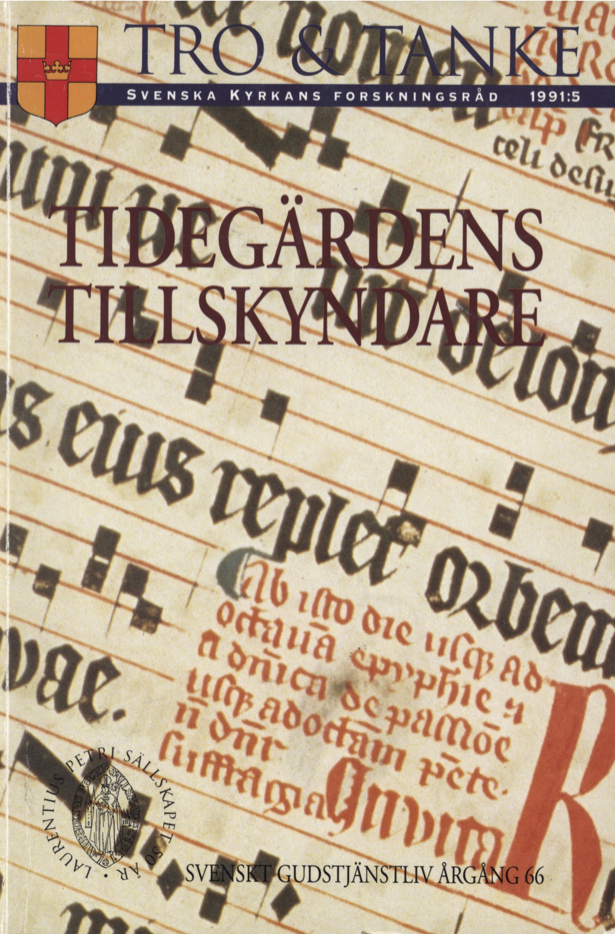Knut Peters och den svenska tidegärden
Abstract
Knut Peters was born in 1894 at Fjällbacka in the diocese of Gothenburg. After studies at the University of Uppsala, he was ordained in Gothenburg in 1916. For ten years he was pastor in the parish of V Tollstad in the diocese of Linköping. In 1930 he became rector of the parishes of Söndrum and Vapnö in the diocese of Gothenburg. He died in 1951.
Peters’ years in Uppsala coincided with a renewal in the church music field. Edvard Rodhe had in 1917 published his dissertation on church music manuscripts from the Reformation period in the Church of Sweden. Quite a few research works on the same lines were published, e g by Tobias Norlind, Nathanael Fransén, Carl-Allan Moberg and in Finland Olav Schalin. Composers as Otto Olsson, John Morén, Richard Norén and others gave the Gregorian tunes a new place in the 20th century church music.
Peters’ studies were focused upon Laurentius Petri, the first evangelical archbishop of Sweden, and his learned and practical efforts for the liturgical life and the ecclesiastical song in the reformed church of Sweden. Peters started studying the Gregorian music in its medieval context and its function during the Reformation century and onwards in order to make these musical treasures known and used in the liturgical life of today’s Church.
As pastor at V Tollstad Peters met Arthur Adell, who was at the time pastor of Stjämorp, not far from Peters’ parish. This was the beginning of a life-long friendship and co-operation. Peters was the learned researcher, Adell the more practical man, both with a deep feeling for the values of Church music and for the need of a renewal of liturgical life and prayer.
Together they edited the first leaflet of "Evangelisk tidegärd" in 1924: the Sunday hours. In 1934, "Veckans tideböner" followed: four hours for weekdays, nine for Sundays. The books were rather widely used - less as sung than as said hours.
But the work continued. In 1939, "Svensk tidegärd" appeared, containing the hours for the whole ecclesiastical year, and in the 1944 edition (of Den svenska tidegärden) the material was completed. A special music edition was "Svenskt antifonale" I (1949), and II (1959) - but by then Peters was dead.
The above was all an enormous achievement. It requested a general survey of medieval and later material, a painstaking accuracy and a keen sense for the needs of liturgy today. Peters and Adell founded the Laurentius Petri Society which has arranged church music conferences and published a series of old church music manuscripts and prints. The series comprises e g Missale Lundense, Graduate Arosiense and Breviarium Lincopense. The latter edition is a work by Knut Peters, even though he edited but the first volume (in 1950) before he died.
The Laurentius Petri Society also publishes the periodical Svenskt gudstjänstliv, where Knut Peters made important contributions on Breviary and Mass music.
Knut Peters was a friendly and peaceful man, humourous and ironical, but he was roused when sober musical style was in danger. In his opinion this was the case when the new Hymn-book (1937) presented quite a few Anglo-Saxon texts and tunes. He and Albert Runbäck published "Svensk koralbok", which offered a stricter choice of melodies. The official Hymn-Book Commission, heralded by bishop Gustaf Aulén, opposed strongly, and the fight continued for some years until it eventually eased off. One wonders what Knut Peters would have thought and said, if he had seen the present Hymn-book of the Church of Sweden!
Knut Peters’ articles in the periodical Svenskt gudstjänstliv dealt not only with the Breviary music but also with the Mass, e g the Introit, the Preface and the Creed. The fact that the Mass books of the Church of Sweden represent Gregorian music in an unusually pure form is partly due to the efforts of Knut Peters and Arthur Adell.
Downloads
Published
Issue
Section
License
© the authors, Laurentius Petri Sällskapet för Svenskt Gudstjänstliv and Artos & Norma Bokförlag. Copying and using material from Svenskt Gudstjänstliv for scholarly purposes is permitted as long as the source is indicated. For other uses, please contact the respective author as well as the publisher. Special restrictions may apply to images.


